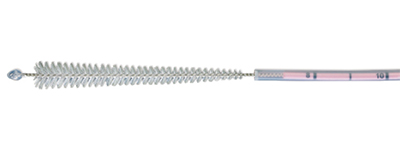Historically, the presence of an endocervical/transformation (EC/TZ) component was considered a measurement of quality of the Pap test, implying that the transformation zone was adequately sampled, which indirectly represents the competence of the individual performing the Pap test, or the individual (cytotechnologist or pathologist) interpreting the Pap. The phrase ‘no endocervical component present’ carries negative connotations for both the clinician, the patient and is occasionally met with questions and concern. However, there are several reasons why an EC/TZ component may not be present. These are absolutely independent of clinician skill or collection method. In our experience, bacterial vaginosis and fungal infections may cause an increased likelihood of EC/TZ absence. Also, increased age results in the transformation zone migrating higher in the endocervical canal,making sampling more difficult. A combination of cytobrush and spatula usually yields an adequate EC/TZ component. Additionally, multiple recent studies have shown that the absence of endocervical cells is NOT associated with a higher risk of cervical disease. Longitudinal studies have demon-strated that women whose Pap tests did not contain endocervical cells were not at higher risk than those who did show endo-cervical cells in their Pap test. The current ASCCP guidelines have changed to reflect this new evidence1 Negative Pap tests with absent EC/TZ components have been shown to have the same risk for CIN 3+ over time, as women with EC/TZ present on Pap2-4 Additionally, high risk HPV testing is apparently independent of TZ sampling-5which offers an additional margin of safety for women when co-testing is performed, which is one of the many reasons why we advocate co-testing.
Article Highlights:
- Patient Age, Bacterial Vaginosis or Candida infections may cause a lack of an EC/TZ component.
- The lack of EC/TZ component is not related to clinician skill.
- Recent evidence shows no increased risk for patients without EC/TZ on Pap test and earlier, repeat testing is not necessary.

The MatrixBrush, exclusive to PathAdvantage, offers a more comfortable method of endometrial sampling, that retains diagnostic accuracy and sensitivity.
BIBLIOGRAPHY 1 https://www.asccp.org/Guidelines 2 Mitchell HS. Longitudinal analysis of histologic high grade disease after negative cervical cytology according to endocervical status. Cancer 2001;93:237Y40 3 Elumir-Tanner L, Doraty M. Management of Papanicolaou test results that lack endocervical cells. CMAJ 2011; 183:563Y8. 4 Huang A, Quinn M, Tan J. Outcome in women with no endocervical component on cervical cytology after treatment for high-grade cervical dysplasia. Aust NZ J Obstet Gynaecol 2009;49:426Y8. 5 Zhao C, Austin RM. Human papillomavirus DNA detection in ThinPrep Pap test vials is independent of cytologic sampling of the transformation zone. Gynecol Oncol 2007; 107:231Y5. Article written by PathAdvantage pathologists Richard Hopley, MD.
 Richard Hopley, M.D. | 06/20/2018
Richard Hopley, M.D. | 06/20/2018